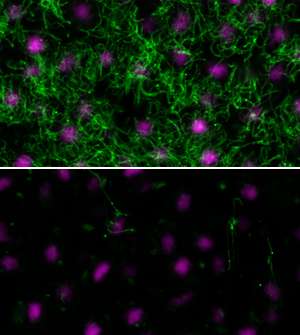The origins of a genetic switch

Cilia, microscopic whip-like organelles that protrude from the surface of many cell types, are almost ubiquitous. They are present in all eukaryotes—organisms whose cells have a nucleus—and have diversified to perform a huge variety of functions, from making cells mobile to sensing light. In vertebrates, nearly every cell in the body has some form of cilia. It has now been shown that the development of cilia—in even the most evolutionarily ancient animals—is controlled by the same gene, FoxJ1. The finding is the result of research from an international team led by Sudipto Roy of the A*STAR Institute of Molecular and Cell Biology (IMCB).
Biologists knew that FoxJ1 is essential for cilia formation in vertebrates, but little about how cilia develop in other organisms. Roy's team searched for similar genes in over 200 diverse groups of organisms, including algae, fungi, amoebas, plants, insects and sea urchins. They found FoxJ1 present only in animals and fungi—groups which originated long ago—indicating that FoxJ1 may be nearly a billion years old.
The function of a gene can change over the course of evolutionary time, so it is possible that FoxJ1 homologs in lower animals do not control cilia development. Using two complementary methods, Roy's group tested this possibility. First, they 'knocked down,' or silenced, FoxJ1 in a simple animal often used to study cilia: the flatworm, Schmidtea mediterranea. As predicted, cilia development was strongly impaired (see image).
The researchers then took FoxJ1 genes from primitive animals and expressed them in the zebrafish, a common model of animal development. FoxJ1 switched on the same genes as would the zebrafish's FoxJ1 homolog. These two lines of evidence indicate that control of cilia development has changed little over hundreds of millions of years; the same gene regulates the process in both humans and the earliest animals to evolve.
Cilia perform a wide range of functions in humans, and studying their development may help in the treatment of diseases, Roy notes. "Motile cilia that line our respiratory passages beat to clear mucus that entraps pathogens and pollutants that we breathe in, and immotile primary cilia function as hubs for a number of signaling pathways," he explains. "Dysfunctional cilia lead to a number of diseases that are collectively called ciliopathies."
Roy's team recently identified a large collection of genes that are activated by FoxJ1 during cilia formation. "We are systematically studying the functions of these genes in cilia and their contribution to ciliopathies," he says.
More information: Vij, S., Rink, J. C., Ho, H. K., Babu, D., Eitel, M. et al. Evolutionarily ancient association of the FoxJ1 transcription factor with the motile ciliogenic program. PLOS Genetics 8, e1003019 (2012). www.plosgenetics.org/article/c … tion?articleURI=info%3Adoi%2F10.1371%2Fjournal.pgen.1003019
Journal information: PLoS Genetics
















